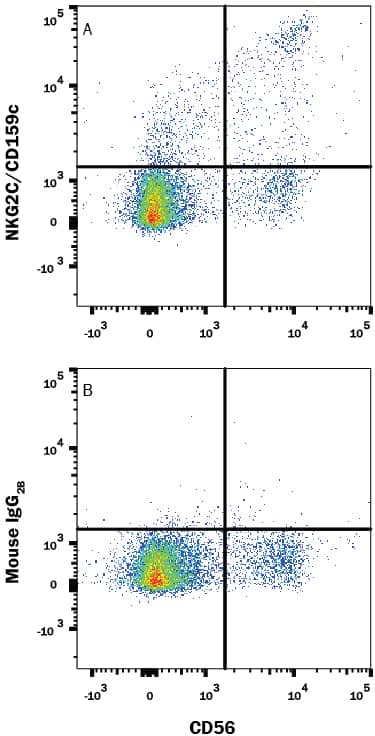Human NKG2C/CD159c Antibody
R&D Systems, part of Bio-Techne | Catalog # MAB1381


Conjugate
Catalog #
Key Product Details
Species Reactivity
Validated:
Human
Cited:
Human, Primate - Callithrix jacchus (Common Marmoset)
Applications
Validated:
CyTOF-reported, Flow Cytometry
Cited:
Affinity Chromatography, CyTof, ELISA Capture, Flow Cytometry, Immunoprecipitation, Neutralization
Label
Unconjugated
Antibody Source
Monoclonal Mouse IgG2B Clone # 134522
Product Specifications
Immunogen
BaF3 mouse pro-B cell line transfected with human NKG2C/CD159c and CD94
Specificity
Detects human NKG2C/CD159c. Detects human NKG2C/CD159c as part of the NKG2C/CD94 heterodimer in flow cytometry. Nocross-reactivity with the human NKG2A/CD94 heterodimer or with the human CD94 homodimer is detected.
Clonality
Monoclonal
Host
Mouse
Isotype
IgG2B
Scientific Data Images for Human NKG2C/CD159c Antibody
Detection of NKG2C/CD159c in Human Blood Lymphocytes by Flow Cytometry.
Human peripheral blood lymphocytes were stained with Mouse Anti-Human NCAM-1/CD56 APC-conjugated Monoclonal Antibody (Catalog # FAB2408A) and either (A) Mouse Anti-Human NKG2C/CD159c Monoclonal Antibody (Catalog # MAB1381) or (B) Mouse IgG2BFlow Cytometry Isotype Control (Catalog # MAB0041) followed by Phycoerythrin-conjugated Anti-Mouse IgG Secondary Antibody (Catalog # F0102B). View our protocol for Staining Membrane-associated Proteins.Applications for Human NKG2C/CD159c Antibody
Application
Recommended Usage
CyTOF-reported
Strauss-Albee, D.M. et al. (2015) Sci. Transl. Med. 7: 297ra115. Ready to be labeled using established conjugation methods. No BSA or other carrier proteins that could interfere with conjugation.
Flow Cytometry
0.25 µg/106 cells
Sample: Human peripheral blood lymphocytes
Sample: Human peripheral blood lymphocytes
Reviewed Applications
Read 4 reviews rated 4.5 using MAB1381 in the following applications:
Formulation, Preparation, and Storage
Purification
Protein A or G purified from hybridoma culture supernatant
Reconstitution
Reconstitute at 0.5 mg/mL in sterile PBS. For liquid material, refer to CoA for concentration.
Formulation
Lyophilized from a 0.2 μm filtered solution in PBS with Trehalose. *Small pack size (SP) is supplied either lyophilized or as a 0.2 µm filtered solution in PBS.
Shipping
Lyophilized product is shipped at ambient temperature. Liquid small pack size (-SP) is shipped with polar packs. Upon receipt, store immediately at the temperature recommended below.
Stability & Storage
Use a manual defrost freezer and avoid repeated freeze-thaw cycles.
- 12 months from date of receipt, -20 to -70 °C as supplied.
- 1 month, 2 to 8 °C under sterile conditions after reconstitution.
- 6 months, -20 to -70 °C under sterile conditions after reconstitution.
Background: NKG2C/CD159c
References
- Orbelyan, G.A. et al. (2014) J. Immunol. 193:610.
- Tassi I. et al. (2006) Immnunol Rev. 214:92.
- Lanier, L.L. (2008) Nat. Immunol. 9:495.
- Schleinitz, N. et al. (2010) Immunology. 174:2878.
- Lopez-Botet, M. et al. (2000) Hum. Immunol. 61:7.
- Braud, V.M. et al. (1998) Nature. 391:795.
- Lanier, L.L. (1998) Immunity 8:693.
- Vance, R.E. et al. (1999) J Exp Med 190:1801.
- Kaiser B.K. et al. (2005) J Immunol 174:2878.
- Bellón T. et al. (1999) J Immunol 162:3996.
- Pupuleku A. et al. (2017) Front Immunol. 8:1317.
- Hammer Q. et al. (2018) Nat Immunol. 19:453.
- Alici, E. et al. (2008) Blood 111:3155.
- Coupel, S. et al. (2007) Blood 109:2806.
- Fausther-Bovendo, H. et al. (2008) AIDS 22:217.
Long Name
Natural Killer G2C
Alternate Names
CD159c, KLRC2, NKG2-C
Gene Symbol
KLRC2
Additional NKG2C/CD159c Products
Product Documents for Human NKG2C/CD159c Antibody
Product Specific Notices for Human NKG2C/CD159c Antibody
For research use only
